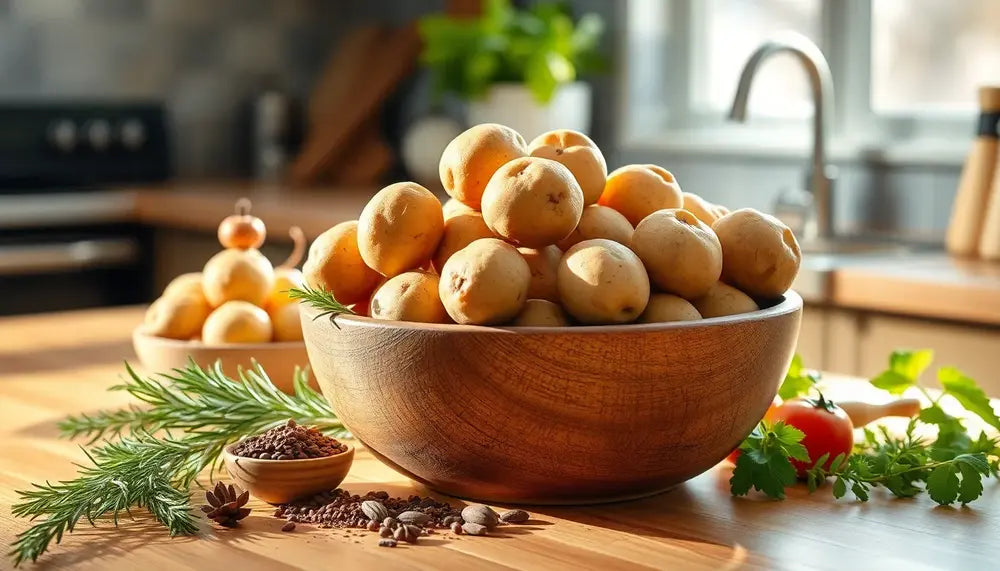Introduction
This Spice paprika is a real all-rounder in the kitchen. It not only gives dishes a beautiful color, but also a unique aroma. Whether mild or hot, paprika is used in many recipes and can be used in a variety of ways. In this article you will learn everything you need to know about the origin, production and use of peppers in your kitchen. Beginners in particular will discover useful tips and tricks here.
What is Paprika?
Paprika is a Spice, which is obtained from the dried and ground pods of the pepper plant. The plant belongs to the nightshade family and has its origins in South America. It is cultivated worldwide in various varieties that differ in shape, color and level of spiciness.
The pods can be sweet or spicy. This depends on the capsaicin content, the substance responsible for the spiciness. Sweet peppers contain little to no capsaicin, while hot varieties have a higher content.
Peppers come in different colors such as red, yellow and green. These colors are caused by different levels of ripeness and types of fruit. Red pepper is the most common in dried form and powder.
The origin of peppers
The pepper plant originally comes from South America. Thousands of years ago, the continent's indigenous people used the pods both as food and as medicine. With the discovery of America by Christopher Columbus, peppers came to Europe and quickly spread across the entire continent.
Today the main pepper growing areas can be found in countries such as Hungary, Spain, Romania and Bulgaria. These regions offer ideal climatic conditions for growing the plant. Hungary is particularly known for its high-quality pepper varieties and plays a leading role in global exports.
Thanks to the plant's global distribution and adaptability, there is now a wide variety of pepper varieties that can thrive in different climates. This makes it possible Spice to be available all year round.
Growing areas and varieties
Pepper growing areas are spread around the world. In addition to the countries already mentioned such as Hungary and Spain, there are also significant cultivated areas in Central and South America, as well as in Asia. Each of these regions has its own special types of peppers, which are characterized by different flavors and levels of spiciness.
Here is an overview of some important pepper varieties:
- Delicacy: This variety has a mild taste and a light red color. It contains no ribs or seeds.
- Noble sweet: Noble sweet is spicy and has a deep red color. This variety contains few seeds and is very popular in the kitchen.
- Semi-sweet: Semi-sweet has a sharper aromatic profile and a yellowish red nuance. It contains more seeds than the milder varieties.
- Rose peppers: This variety is very spicy and has a dark red to yellowish red color. It contains many seeds and ribs, which contributes to the intense spiciness.
- Pimentone (smoked): Pimentone is characterized by a smoky aroma and is available in both mild and hot versions. This variety is often used in Spanish cuisine.
Each of these varieties offers unique flavor profiles that allow for different culinary applications. Choosing the right variety can significantly impact the taste of your dish.
Production of paprika powder
Making paprika powder is a careful process that involves several steps. First, the ripe peppers are harvested and cleaned. The pods are then dried, which is traditionally done in the sun or in special drying systems. This step takes approximately three to four weeks.
Once the pods are completely dry, they are cored and the ribs removed. This is particularly important for milder varieties such as delicacy and Noble sweet, as the seeds and ribs often contain more capsaicin and are therefore spicier.
The dried pods are then ground into a fine powder. It is important that the grinding takes place evenly to ensure a uniform consistency. The finished paprika powder is then packaged and ready for sale.
The quality of the paprika powder depends heavily on the care taken in each individual production step. High-quality paprika powder can be recognized by its intense color and strong aroma.
Aroma and taste of the different types of peppers
The different types of peppers offer a wide range of aromas and flavors. Depending on the variety, this can be the case Spice be mild, spicy or very hot. Here are the key differences:
- Delicacy: This variety has a mild, sweet taste and a fruity aroma. It is ideal for dishes that only need a subtle seasoning.
- Noble sweet: Edelsüss is slightly spicier than Delikatess and has a fuller, more intense taste. The aroma is rich and slightly sweet.
- Semi-sweet: Semi-sweet combines sweet and spicy notes. The taste is aromatic with a pleasant spiciness in the finish.
- Rose peppers: This variety is known for its strong spiciness and intense aroma. The flavor is deep and complex, making it ideal for bold dishes.
- Pimentone (smoked): Pimentone has a unique smoky aroma that comes from smoking the pods over oak wood. The taste can be both mild and spicy, depending on the variant.
Choosing the right type of pepper depends on the flavor you want in your dish. While delicacy and noble sweet are ideal for mild dishes, semi-sweet and rose pepper are ideal for dishes that require more spice.
Pimenton gives grilled dishes and stews a distinctive smoky aroma. Experiment with the different varieties to find out which one works best with your favorite recipes.
Possible uses in the kitchen
Paprika is extremely versatile Spice, which can be used in many different dishes. It goes well with both savory and sweet dishes and adds color and flavor. Here are some of the most common uses:
- Soups and stews: Peppers are great for soups and stews. It gives classic dishes like goulash or lentil soup a deep, spicy note.
- Sauces: Whether tomato sauce, BBQ sauce or curry sauce - peppers can significantly improve the taste of sauces.
- Egg dishes: A touch of paprika in scrambled eggs or omelettes adds additional flavor and color.
- Meat and fish dishes: Paprika is a popular spice for marinades and rubs. It goes well with poultry, beef, pork and fish.
- Vegetable dishes: Roasted or grilled vegetables get an extra kick from paprika. It goes particularly well with potatoes, zucchini and eggplant.
- Cheese dishes: Sprinkle some paprika over cheese dishes like casseroles or fondue to give them a special touch.
In addition to these classic uses, you can also experiment with peppers. Try it in desserts like chocolate mousse or fruit compote for a surprising flavor twist. A little paprika can also enhance the dressing in salads.
Whether sweet or spicy, the right paprika powder can take your dishes to a new level. Try out different varieties and find out which ones go best with your culinary creations.
Storage tips for paprika powder
To ensure that your paprika powder stays fresh and aromatic for a long time, proper storage is crucial. Here are some tips to ensure the quality of yours spices to preserve:
- Store in a cool and dry place: Store the paprika in a cool, dry place. Moisture and heat can affect the aroma and color.
- Light protection: Store the powder in an opaque container or in a dark place. Light can break down the essential oils in peppers and cause the spice to fade.
- Aroma-tight containers: Use airtight containers to minimize air infiltration. Oxygen can deteriorate the taste and quality of the powder.
- Buy small quantities: It's better to buy smaller quantities that you can use within a few months. This way you can ensure that you always have fresh paprika powder on hand.
- Keep away from strong smells: Do not store paprika powder near strong-smelling foods or spices. The powder can easily absorb foreign flavors.
A good trick is to write the date of purchase on the container. This way you can keep track of how long the powder has been stored. Fresh paprika powder has an intense aroma and a bright red color. If it starts to lose its color or smell, it's time for a refill.
By following these simple storage tips, you can ensure that your paprika powder remains at its best quality and continues to enrich your dishes with full flavor.
Kitchen tips for using peppers
This Spice paprika can be used in a variety of ways in the kitchen. Here are some practical tips to get the most out of your paprika:
- Fat as a flavor carrier: Paprika develops its full flavor best when dissolved in fat. When sautéing or frying, simply add some paprika powder to the hot oil or butter.
- Add spicy varieties at the end: To avoid bitterness, add hot peppers such as rose peppers toward the end of cooking.
- Do not fry too hot: Avoid frying paprika over too high a heat. The powder can burn quickly and become bitter. At medium heat it retains its sweet and aromatic taste.
- Mixing with other spices: Combine peppers with other spices like garlic, onions, or cumin for complex flavor profiles. This mixture brings depth and spice, especially in stews and sauces.
- Red Pepper Flakes for Texture: In addition to ground paprika, use red pepper flakes to add additional texture and visual accent to your dishes.
Another tip: "The redder, the milder." A bright red color often indicates a milder variety, while a dull brown-red often means a spicier flavor. This is because spicier varieties may contain more seed content.
Remember that peppers can also be used outside of traditional cuisine. A touch of smoked pimenton adds a special touch to grilled vegetables or even chocolate desserts. Experiment and find out which combinations you like best.
Conclusion
Peppers are incredibly versatile Spice, which should not be missing in any kitchen. It offers a wide range of flavors, from mild and sweet to spicy and smoky. The different varieties allow you to refine many different dishes and give them a special touch.
Whether in soups, sauces, meat or vegetable dishes - peppers can significantly improve the taste of your food. With the right storage and usage tips, you can ensure that your paprika powder always stays fresh and develops its full aroma.
Experiment with the different varieties and find out which ones go best with your favorite recipes. This way you can take full advantage of the versatility of peppers and take your culinary creations to a new level.
Thanks to its easy handling and wide range of uses, paprika is an essential for both beginners and experienced cooks Spice. Try it out and discover the many facets of this wonderful spices.
Everything you need to know about peppers
What is Paprika?
Paprika is a spice made from the dried and ground pods of the pepper plant. The plant belongs to the nightshade family and has its origins in South America.
Where does pepper come from?
Peppers originally come from South America. Today peppers are mainly grown in countries such as Hungary, Spain, Romania and Bulgaria.
What types of peppers are there?
There are different types of peppers such as delicacy, noble sweet, semi-sweet, rose pepper and pimenton (smoked). These differ in taste and level of spiciness.
How is paprika powder made?
To make paprika powder, the pods are dried and then ground. Drying usually takes place in the sun or in special drying systems and takes around three to four weeks.
How do you store paprika powder correctly?
Paprika powder should be stored in a cool, dry and dark place. Use airtight containers to preserve the aroma and keep it away from strong smells.





Share:
Exotic spices from India: Discover the diversity of Indian cuisine
All in one: The spice set for ambitious chefs